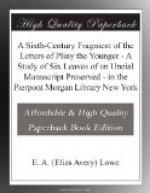[Footnote 38: C.P. V, pp.
467 ff. and 476 ff., and for the
supposed lack of indices in P,
p. 485.]
[Footnote 39: I venture to disagree
with Dr. Lowe’s view (above,
p. 25) that the addition is by the first
hand.]
[Footnote 40: See above, p. 11.]
[Footnote 41: See plate XIV.]
These details prove an intimate relation between _{Pi}_ and BF, and fit the supposition that B and F are direct descendants of _{Pi}_. This may be strengthened by another consideration. If _{Pi}_ and B independently copy the same source, they inevitably make independent errors, however careful their work. _{Pi}_ should contain, then, a certain number of errors not in B. As we have found only three such cases in 12 pages, or 324 lines, and as in all these three the right reading in B could readily have been due to emendation on the part of the scribe of B or of a copy between _{Pi}_ and B, we have acquired negative evidence of an impressive kind. It is distinctly harder to believe that the two texts derive independently from a common source. Show us the significant errors of _{Pi}_ not in B, and we will accept the existence of that common source; otherwise the appropriate supposition is that B descends directly from its elder relative _{Pi}_. It is not necessary to prove by an examination of readings that _{Pi}_ is not copied from B; the dates of the two scripts settle that matter at the start. Supposing, however, for the moment, that _{Pi}_ and B were of the same age, we could readily prove that the former is not copied from the latter.




